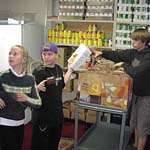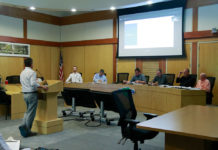A statewide survey on hunger indicates that 21,000 low-income
Sonoma County residents, roughly five percent of the population,
can’t always afford to put food on the table — and half of those
people go hungry on a regular basis.
But those who operate the county’s food pantries and food
distribution centers say the number of hungry people is much higher
in Sonoma County and many hungry families are not receiving their
services.
The survey, conducted last year by the UCLA Center for Health
Policy Research, included families living with incomes below 200
percent of the federal poverty level, which is $36,000 for a family
of four. It found that more than 2.24 million adults experience
“food insecurity” and that a third of those experience regular
episodes of hunger pains.
David Goodman, executive director of the Redwood Empire Food
Bank, said the survey “gives us some insight into a subset … but it
doesn’t tell us who is hungry. It tells us that hunger exists for a
certain group of people.”
The Redwood Empire Food Bank serves 38,000 people per month, so
Goodman knows that there are more than 21,000 hungry people in
Sonoma County that are hungry. He points out that the survey
measures only families at a $36,000 income level, while a
California Budget Project study showed that a Sonoma County family
of four needs a $62,000 income to make ends meet.
“What we know is how many people we reach, not how many people
are hungry. You may be earning less than $62,000 and you are short
of cash and you have to start making choices –you have to pay the
electric bills and the medical bills. What happens with food
insecurity is that people have to make tough decisions … sometimes
it’s parents skipping meals so their kids can eat. But they are not
necessarily showing up at our doors. The challenge is to find out
who is not being served.”
Ida Spiller, coordinator of the Windsor Service Alliance Food
Pantry, said an average of 85 families pick up food at the pantry
each Friday. She said that the Windsor community has been very
supportive of the pantry, but without the food pantry service,
“people probably would go hungry.”
Goodman said it would be impossible to extrapolate the number of
hungry county residents using the survey results — and
useless.
“What I’m saying is what difference does it make? If the number
is 21,000 or 25,000 … is one number more alarming than the other?”
said Goodman. “Our community has no concept of what 38,000 people
getting our services means. The right message is that hunger should
not exist in our community, in America, and certainly not in Sonoma
County. I can’t think of a single good reason why hunger should
exist here. We have the resources and the capacity. We’re just
talking about food.”
Susan Graf, co-chair of the Food Pantry operated by the
Healdsburg Shared Ministries, believes that “food is a right, not a
privilege and nobody should be hungry.”
Last Friday, more than 225 people received food from the
Healdsburg Avenue pantry. “My biggest point is that the people we
are serving are working. These are not people on the dole. They are
working and are not making enough to buy enough food for their
families,” said Graf.
Goodman agrees. “There are hungry people who have money,” he
said. “It’s all about income and expenses in this community. People
are hungry that are working.”
Graf thinks the UCLA survey underestimates the extent of hunger
in Sonoma County. “I think there is a huge gap between the survey
and the need,” said Graf. “The point is trying to mobilize the
communities … we need manpower and donations.”
Graf and pantry co-chair Robin Ridder make a weekly trip to the
Redwood Empire Food Bank to stock the Healdsburg pantry — but it’s
still not enough. “We’re moving 1,500 pounds a week of food,
minimum. Last week we had 225 people here. We could do more if we
had more volunteers … we could be doing more, but physically we
can’t … there’s only so much two girls and a 12-year-old pickup
truck can do.”
Graf said in 2002 donations are down and demand is up. “The
survey was done before 9/11 and things are a hell of a lot worse
now than they were before 9/11,” she said. “Donations are way
down.”
Goodman said one of the challenges he faces is “trying to give
some perspective on this whole issue for people. How do we get
people to understand the magnitude of this issue and how easy it is
to address. It can be as simple as providing food. We have children
going to should who don’t have enough to eat. We should have
mandatory school breakfasts.
“Our communities need to acknowledge that there are people in
emergency food needs and there are chronic needs,” said Goodman.
“What can we set up in each community to insure that their
communities have sufficient food resources?
“The easiest thing to do with hunger is to get people food to
eat,” he said. “The hardest thing is to get people involved.”
The UCLA study concludes that “the paradox of food insecurity
and hunger in food-abundant California clearly shows that this
state can do better.”
It recommends increased use of federal food programs, increased
access to food stamps and other assistance and provide more
children with school meals.
The study is available at www.healthpolicy.ucla.edu.









